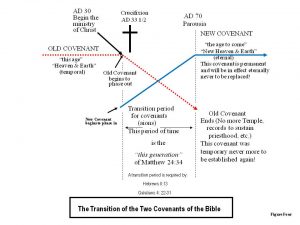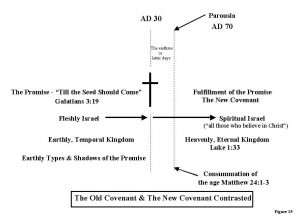The Transition of the Bible Covenants
Thus far we have seen that there are two major covenants in the Bible, the Old Covenant and the New Covenant. In this Learning Activity we shall look at the timing of how and when the New Covenant replaced the Old. To do this we must look at the specific language used in the Scriptures to describe this change.
In my opinion and personal experience I had difficulty with this topic because it turned out that the two covenants spent a period of time (40 years!) where they coexisted together side-by-side. This initially seemed to me to be a violation of the the Bible verse that states that God is not an author of confusion (1 Corinthians 14:33), and to have two sets of “rules” operating at the same time sure appeared to me to be “confusion!” After I found definitive proof in the Scriptures itself that this was a biblical fact it began to make sense to me and I was on the road to a more complete understanding. Because of my personal journey on this topic I am going to begin by sharing where in the Scripture that particular fact appears. The background is found in the following passages of the Old Testament. Please read through items 1 and 2 below before proceeding.
1. Genesis 16:1-16
2. Genesis 21:1-14
The two passages above tell the story of Abraham having two wives in his tent at the same time and all the troubles that resulted from Abram and Sarai not believing and trusting God’s promise to them. Now lets look at the zinger or clarification of what God is telling us about these two women.
3. Read Galatians 4:21-31
4. Galatians 4:21: As you read this verse remember that the Law was an integral part of the Old Covenant.
5. Galatians 4:22: Abraham’s two sons Ishmael and Isaac were born from two different wives, Hagar and Sarah. In this verse Hagar is referred to as a slave and Sarah as a free woman. We are also told that under the Old Covenant mankind was a “slave” (because of being under the law) while under the New Covenant there is “freedom” as the law is written on our hearts and is not the law on tablets of stone as it was under the Old Covenant.
6. Galatians 4:23: Ishmael was born of the flesh (which is indicative of the Old Covenant being a fleshly or physical covenant), while Isaac was born through the promise (an act of God as contrasted with man’s doing). Isaac reflects the spiritual nature of the New Covenant. This is a great example of “the flesh” and “the spirit” at work.
7. Galatians 4: 24: In this verse we are informed that the issue of Abraham’s two sons and wives is meant to be an allegory. We are further told that the allegory is depicting the two covenants. The verse then tells us about the allegory and confirms to us that there are two covenants. This is the positive proof the Bible gives us that while Sarah and Hagar spent time living under the same tent with each other, so will the two covenants spend time being in place simultaneously until the one (Old Covenant) is cast out.
Figure Four below depicts what this transition period of time looks like graphically and in time.
Left click your mouse on the graphic to enlarge it. Click on the back arrow to return to the document.
8. Galatians 4:25: Here “the present Jerusalem” is referring to the historical, physical city of Jerusalem in which the Temple was located. The book of Galatians was written before the destruction of the city and temple took place, therefore it is referred to as “the present Jerusalem.”
9. Galatians 4:26: Here we find a second Jerusalem, but this one is not a physical city. The second “comes from above” and is a spiritual city (the New Jerusalem).
10. Galatians 4:28: Paul tells the Galatians (and believerstoday), that we are like Isaac, children of the promise.
11. Galatians 4: 29: Here Paul is writing in reference to a condition that existed at the time he was writing. Just as Isaac was persecuted by Ismael (those of the flesh persecuting those of the spirit), that same kind of persecuting that was taking place during the time that Paul and the Galatians were living in, is taking place today! Those who were moving out of the Old Covenant (the flesh) and into the New Covenant (the spirit) were being persecuted by those who insisted on staying under the law of the Old Covenant.
12. Galatians 4:30: This is a stern warning by paul to the Galatians that they should no longer be a part of the Old Covenant. It was time to leave the bondage of the Old and enter into the freedom of the New.
13. Galatians 4:31: Here the Galatians are reminded that they were to identify themselves no longer to Hagar and Ismael (the slaves), but rather to Sarah and Isaac (the free).
14. Galatians 5:1: Those who have been set free in Christ should NOT submit themselves again to the slavery that the Old Covenant had them previously under.
I covered the additional Bible text beyond the proof of the two simultaneous covenants because that understanding applies to us today and we should all be aware of the total story of “slave” versus “free.”
15. Matthew 24:3
16. In the verse above, Jesus was sitting on the Mount of Olives overlooking Jerusalem and the Temple. In verse two Jesus tells the disciples that were with Him that the time is coming when everything they see will be characterized by “There shall not be left here one stone upon another, that shall not be thrown down.” The specific question they asked Jesus was: what would be the sign of His coming, and of the end of the age? The word “world” in the KJV is incorrect and should be “age.”
From the above verse and our previous Learning Activities, what age (covenant) were they in at the time this conversation took place?
17. In the scripture above, what does the phrase “the sign of thy coming” mean to you?
It is an historical fact (to be shown in a later Learning Activity) that the destruction of the city of Jerusalem and the Temple as prophesied by Jesus in verse two took place physically in AD 70 when the Roman army leveled the city!
18. Mark 10: 30 (Note: The word “world” in the KJV is “ages.”
19. What did Jesus say about eternal life in the verse above?
20. Ephesians 1:21 (Note: The word “world” in the KJV should be translated “age.”
21. The best scholarship places the writing of the book of Ephesians at about AD 64. What conclusion can you arrive at as to what point in the two ages (covenants) Paul wrote this statement?
22. Hebrews 1:2
23. In the verse above, the KJV translates “worlds” incorrectly as it should be “ages.” What is the time period mentioned in this verse when the Father sent His Son to speak to the people when this book was written?
24. Hebrews 6:5 (Note: In the KJV, the word “world” in this verse should be “age.”
25. What period of time in the two covenants is the author of the book of Hebrews writing?
Finally, a graphic illustrating the two covenants contrasted against each other is illustrated in Figure Fifteen below.
Left click your mouse on the graphic to enlarge it. Click on the back arrow to return to the document.
From this Learning Activity we see the transition time of the two covenants. As the scripture records the Old Covenant passing away it similarly records the replacement of the Old with the New. The Old was over as it began to pass away but as long as the Temple stood in Jerusalem people kept following the Old. It was just a matter of time that ended with the AD 70 destruction of the physical city of Jerusalem, the Temple, and the Levitical priesthood that took place when the Roman Army led by Titus demolished these physical artifacts of the time. All of these had spiritual replacements or fulfillment that were already being placed into position by the coming of the New Covenant. It is only man hanging onto attributes of the Old Covenant that we still see today as a residue of what God carefully engineered as the replacement for those Old Covenant ordinances and practices. They have no purpose and are ineffectual today in the eternal New Covenant. A person reading their Bible today must be able to divide in their thinking whether a passage being read is describing the Old Covenant or the New Covenant else they are living in obsolete past history!
Click on Self-Check below to check your answers.

